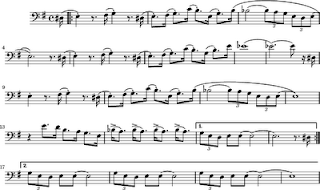To engrave The Pink Panther theme using LilyPond, I had to learn a few more useful tricks.
- To display upbeats, use the \partial command followed by duration of the interval before the start of the first complete measure. In the beginning of The Pink Panther theme, we have
\partial 16 dis16( | i.e. the duration of the interval is 1/16. The semiquaver D♯ is followed by the enforced bar line | (after which, by default, bar lines and bar numbers are calculated automatically). - Slur (or legato) is indicated with parentheses, ( and ), placed after the first and last note of the legato group, respectively.
- Similarly, phrasing slur is indicated with \( and \).
- To add staccato articulation, place either \staccato or its shorthand -. after a note. For illustration purposes, I used both in my source.
- Similarly, to add accent, place either \accent or -> after a note.
- To write a tuplet, one has to multiply the durations by a fraction. In triplet, the three notes have the duration of two notes, thus the fraction is 2/3. For example,
\times 2/3 { e8 d8 e8 } - To introduce repeat, use
\repeat volta number of repeats {music expression to be repeated} For alternate endings, type\alternative { {alternative ending A} {alternative ending B} } In the example below, I repeat the whole theme twice (hence \repeat volta 2) and use two alternate endings.
% ****************************************************************
% The Pink Panther Theme (Henry Mancini)
% ****************************************************************
\version "2.12.3"
\score {
\new Staff
{
\clef bass
\key e \minor
\partial 16
dis16( |
\repeat volta 2 {
e4\staccato) r8. fis16( g4-.) r8. dis16(
e8.-.) fis16( g8.-.) c'16( b8.-.) e16( g8.-.) b16\(
bes2( \times 2/3 { bes8) a8 g8 } \times 2/3 { e8 d8 e8( }
e2.)\) r8. dis16(
e4-.) r8. fis16( g4-.) r8. dis16(
e8.-.) fis16( g8.-.) c'16( b8.-.) g16( b8.-.) e'16
ees'1(
ees'2.)( ees'8) r16 dis16
e4-. r8. fis16( g4-.) r8. dis16(
e8.-.) fis16( g8.-.) c'16( b8.-.) e16( g8.-.) b16\(
bes2( \times 2/3 { bes8) a8 g8 } \times 2/3 { e8 d8 e8( }
e1)\)
r4 e'8. d'16 b8. a16 g8. e16
bes16\accent( a8.) bes16->( a8.) bes16->( a8.) bes16->( a8.) }
\alternative {
{ \times 2/3 { g8 e8 d8 } e8 e8( e2)(
e2.) r8. dis16 }
{ \times 2/3 { g8 e8 d8 } e8 e8( e2)
\times 2/3 { g8 e8 d8 } e8 e8( e2)
\times 2/3 { g8 e8 d8 } e8 e8( e2)(
e1) }
}
}
}And here’s the result:
Ta-da!





No comments:
Post a Comment